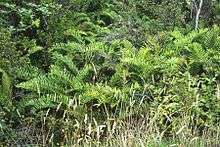Blechnum
Blechnum, known as hard fern, is a genus of ferns in the family Blechnaceae, subfamily Blechnoideae, according to the Pteridophyte Phylogeny Group classification of 2016 (PPG I).[1] Two very different circumscriptions of the genus are used by different authors. In the PPG I system, based on Gasper et al. (2016),[2] Blechnum is one of 18 genera in the subfamily Blechnoideae, and has about 30 species.[1] Other sources use a very broadly defined Blechnum s.l., including accepting only two other genera in the subfamily. The genus then has about 250 species.[3] In the PPG I circumscription, the genus is mostly neotropical, with a few southern African species.
| Blechnum | |
|---|---|
 | |
| Blechnum chilense | |
| Scientific classification | |
| Kingdom: | Plantae |
| Clade: | Tracheophytes |
| Class: | Polypodiopsida |
| Order: | Polypodiales |
| Suborder: | Aspleniineae |
| Family: | Blechnaceae |
| Subfamily: | Blechnoideae |
| Genus: | Blechnum L. |
| Type species | |
| Blechnum occidentale | |
| Species | |
Species
Using the PPG I circumscription, as of December 2019, the Checklist of Ferns and Lycophytes of the World accepted the following species and hybrids.[4]
- Blechnum anthracinum R.C.Moran
- Blechnum appendiculatum Willd.
- Blechnum arcuatum J.Rémy ex Fée
- Blechnum areolatum V.A.O.Dittrich & Salino
- Blechnum asplenioides Sw.
- Blechnum auriculatum Cav.
- Blechnum australe L.
- Blechnum austrobrasilianum de la Sota
- Blechnum × caudatum Cav.
- Blechnum × confluens Schltdl. & Cham.
- Blechnum × falciculatum C.Presl
- Blechnum gracile Kaulf.
- Blechnum gracilipes (Rosenst.) M.Kessler & A.R.Sm.
- Blechnum guayanense A.Rojas
- Blechnum hastatum Kaulf.
- Blechnum heringeri Brade
- Blechnum laevigatum Cav.
- Blechnum lanceola Sw.
- Blechnum × leopoldense (Dutra) V.A.O.Dittrich & Salino
- Blechnum longipilosum V.A.O.Dittrich & Salino
- Blechnum ludificans Herter
- Blechnum malacothrix Maxon & Morton
- Blechnum meridense Klotzsch
- Blechnum occidentale L.
- Blechnum × pampasicum de la Sota & M.L.Durán
- Blechnum polypodioides Raddi
- Blechnum punctulatum Sw.
- Blechnum tomentosum M.Kessler & A.R.Sm.
Cultivation and uses
Several species are grown as ornamental plants in gardens.
Blechnum is also a host plant for the butterfly, Anartia fatima, or the banded peacock, which is common in Central America.[5][6]
References
- PPG I (2016), "A community-derived classification for extant lycophytes and ferns", Journal of Systematics and Evolution, 54 (6): 563–603, doi:10.1111/jse.12229
- Gasper, André Luís De; Dittrich, Vinícius Antonio De Oliveira; Smith, Alan Reid & Salino, Alexandre (2016-09-21), "A classification for Blechnaceae (Polypodiales: Polypodiopsida): New genera, resurrected names, and combinations", Phytotaxa, 275 (3): 191–227, doi:10.11646/phytotaxa.275.3.1, ISSN 1179-3163, retrieved 2019-12-22
- Christenhusz, Maarten J.M. & Chase, Mark W. (2014), "Trends and concepts in fern classification", Annals of Botany, 113 (9): 571–594, doi:10.1093/aob/mct299, PMC 3936591, PMID 24532607
- Hassler, Michael & Schmitt, Bernd (November 2019), "Blechnum", Checklist of Ferns and Lycophytes of the World, 8.11, retrieved 2019-12-22
- Silberglied, Robert E.; Aiello, Annette; Lamas, Gerardo (1979). "Neotropical Butterflies of the Genus Anartia: Systematics, Life Histories and General Biology (Lepidoptera: Nymphalidae)". Psyche: A Journal of Entomology. 86 (2–3): 219–260. doi:10.1155/1979/50172. ISSN 0033-2615.
- Feldman, Tracy S.; Haber, William A. (1998). "Oviposition Behavior, Host Plant Use, and Diet Breadth of Anthanassa Butterflies (Lepidoptera: Nymphalidae) Using Plants in the Acanthaceae in a Costa Rican Community". The Florida Entomologist. 81 (3): 396–406. doi:10.2307/3495929. JSTOR 3495929.
Further reading
- Huxley, A., ed. (1992). New RHS Dictionary of Gardening. Macmillan
- Moore, D. M. (1983). Flora of Tierra del Fuego
External links
| Wikimedia Commons has media related to Blechnum. |